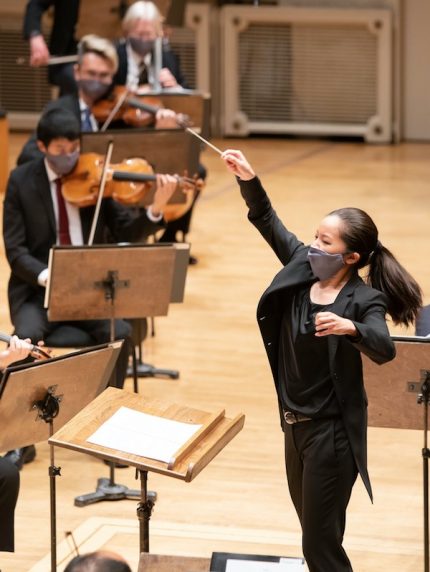CSO returns to full strength with fiery brilliance in wide-ranging program

The middle program of the Chicago Symphony Orchestra’s three-week spring series brought the most intriguing program of the set: a Viennese symphony, a 20th-century Hungarian showpiece and a pair of works by two composers of color.
Most significantly, Thursday night’s concert brought the largest complement of the full symphonic ensemble heard live or online since the pandemic shuttered concert venues last March. And while there were compromises, as with the single-desk strings, hearing the fire, corporate virtuosity and quirky individuality of the CSO for the first time in 15 months was undeniably glorious.
Thursday’s concert at Orchestra Hall also brought the CSO quasi-debut of Erina Yashima (She had led only CSO youth concerts previously.) A protege of music director Riccardo Muti, the German-born conductor won the CSO’s Sir Georg Solti Conducting Apprenticeship and has worked extensively with the Civic Orchestra. Since the fall of 2019 she has been assistant conductor of the Philadelphia Orchestra.
The 80-minute program, sans intermission, began with two of Samuel Coleridge-Taylor’s Novelettes. Though these excerpts from the black Englishman’s Op. 52 were being played by the CSO for the first time, in his lifetime Coleridge-Taylor’s music was promoted by the forward-looking CSO founder Theodore Thomas who programmed an aria from the composer’s cantata Hiawatha’s Wedding-Feast. Coleridge-Taylor’s final work was a Violin Concerto written for Maud Powell before his early death at age 37 in 1912.
The two Novelettes are lightish works, but attractive in their unassuming expression and scored with flair. The lyrical No. 3 in A minor verges on the salon, but concertmaster Robert Chen’s tasteful solo violin obbligato deftly avoided the soup. Contrast is provided with a dance-like middle section, a tambourine and triangle adding color and variety to the string sonority. The Novelette No. 4 in D major offers a vigorous Allegro with a more contemplative middle section.
Yashima led forthright performances of these two miniatures yet this kind of music really needs a lighter touch to blossom, and the conductor’s emphatic direction largely shorted Coleridge-Taylor’s lyrical charm. String tuttis sounded diffuse at times, though with single desks widely spaced out, that issue may have been beyond Yashima’s control.
Jessie Montgomery’s Strum may have been the shortest work on the program but will likely have the most long-term significance over the next few years. In April the composer was named the CSO’s next Mead composer in residence, a post Montgomery will take up in July and hold for a three-year term through 2024.
Strum (2006) was performed in its original string quartet version earlier this year as part of the online CSO Sessions series. Thursday night brought Montgomery’s later arrangement (2012) for string orchestra in the composer’s CSO debut.
Strum is built on a strummed pizzicato theme that opens in solo viola before moving to the solo cello, soon morphing into a bent-note, seesawing motive that has the feel of country blues. Montgomery is a violinist and Strum shows undeniable facility in its string writing. She alternates rhythmic and harmonic ostinati with fluency and elan in a narrative that, in her words, “begins in fleeting nostalgia and transforms into ecstatic celebration.”
Montgomery packs a lot of activity into just seven minutes and this striking debut makes one eager to hear more of her music. Yashima seemed most in her element here, clarifying the varied parts of the different string sections in a spirited performance.
Schubert revered Mozart and his Symphony No. 5 pays homage to his Classical-era predecessor while being imbued with Schubert’s own inimitable voice and charm.
Yet, as in the Coleridge-Taylor pieces, charm was mostly in short supply. Yashima directed the opening Allegro in a brisk, streamlined fashion, void of Viennese warmth and individual touches. In the Andante her direction felt equally impatient, failing to let notes breathe at the ends of phrases with dynamics rarely venturing below a robust mezzo-forte. One tried in vain to get a glimpse of Schubert’s Austrian countryside yet felt it was being viewed from inside a passing bullet train.
The latter movements proved more successful. Yashima’s thrusting accents captured the vigor of the Scherzo with a rustic, nicely idiomatic Viennese lilt in the trio. And the quicksilver finale came off with all due effervescence and energy, a few passing violin slips apart.
How wonderful was it after over a year to hear Stephen Williamson tear it up in the florid clarinet solo of Zoltán Kodály’s Dances of Galánta with typical audacity and panache? The composer’s 1933 work is really a miniature tone poem, working up an array of Hungarian verbunkos tunes into a dazzling symphonic showpiece.
Yashima led a fiery performance that drew out the moody slow sections as surely as the dances’ velocity and brilliance. Williamson’s spicy, echt-Magyar clarinet solos were extraordinary but wind colleagues William Welter and Emma Gerstein also made vivid and characterful solo contributions on oboe and flute respectively.
Note: The CSO announced Thursday that Cristina Rocca will return to the orchestra as vice president for artistic planning later this month. This follows a one-season stint as artistic director of the London Philharmonic Orchestra during the 2020-2021 season. Rocca previously held the same position at the CSO from 2015 through 2020.
The program will be repeated 1:30 p.m. Friday, 7:30 p.m. Saturday and 3 p.m. Sunday. cso.org; 312-294-3000.
Posted in Uncategorized




